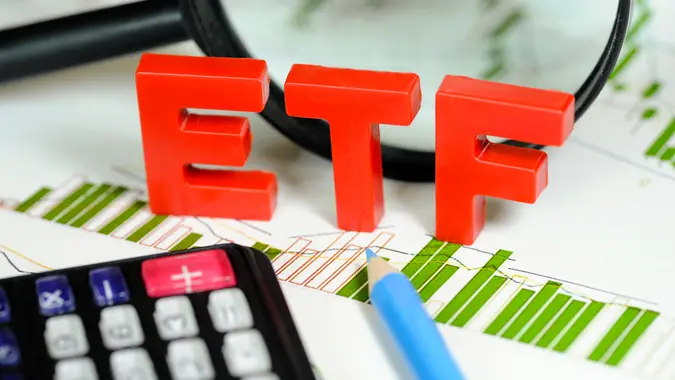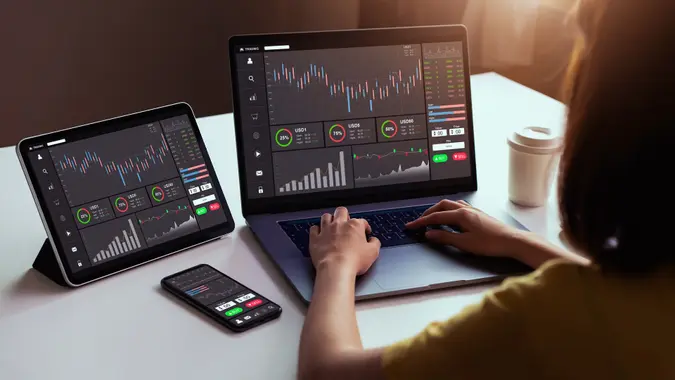How Much Is a Gold Bar Worth in 2025?

Commitment to Our Readers
GOBankingRates' editorial team is committed to bringing you unbiased reviews and information. We use data-driven methodologies to evaluate financial products and services - our reviews and ratings are not influenced by advertisers. You can read more about our editorial guidelines and our products and services review methodology.

20 Years
Helping You Live Richer

Reviewed
by Experts

Trusted by
Millions of Readers
A one-ounce gold bar is worth $3,318.70, as of June 30, 2025. Gold prices fluctuate daily, so if you’re thinking about buying or selling this year, here’s what you should know about its current value and whether it’s still a smart investment in 2025.
Gold Bar Prices in 2025: Breakdown by Size
Gold bars vary in size and this can impact the price. Take a look at these common sizes of bars and their potential cost.
| Bar Size | Weight | Value as of June 30, 2025 |
|---|---|---|
| Small | 1 gram | $106.70 |
| Small | 1 ounce | $3,318.70 |
| Medium | 10-ounces | $33,187 |
| Medium | 1 kilogram | $106,698.68 |
| Large | 400 ounces | $1,327,480 |
Pro Tip
Be sure to check the spot prices of gold daily since they are impacted by global supply, demand, inflation, interest rates and geopolitical events.
Check reputable sources like Kitco, JM Bullion or Reuters for the spot price.
What Affects the Value of a Gold Bar?
The primary factor that impacts how much a gold bar is worth is the spot price. Weight, purity, brand, mint and market demand also impact valuation.
Gold Spot Price
The gold spot price is the current price of one ounce of gold based on supply, economic factors and demand. When interest rates are lower, gold becomes more attractive. Also, when fiat currencies weaken, gold price rises as a hedge against inflation.
Weight and Purity
Gold bars come in various sizes. The most popular size is one ounce or 31.1 grams. Other sizes include:
- 10 ounces: This bar weight is preferred by high-end investors.
- 1 kilogram: Institutional buyers prefer this weight.
- 400 ounces: This is the standard size for central banks and large financial institutions.
Investment-grade gold bars are usually 99.99% pure or 24 karats.
Brand and Mint
Recognized mints give guarantees on weight and purity. Some reputable brands include the following:
- PAMP Suisse
- Credit Suisse
- Valcambi from Switzerland
- Perth Mint from Australia
- Royal Canadian Mint from Canada
Generic bars that may trade at a lower premium lack the same level of purity and trust.
Market Demand
Global events have an influence on gold prices. When the economic market experiences a downturn, gold becomes more in demand. It represents a safer asset. For example, during the Ukraine conflict in 2022, gold prices rose by over 8%.
If other countries are buying gold, this often drives up demand. Also, when the stock market is volatile in terms of the equities market, gold becomes a more attractive purchase. Scarcity, especially when production declines, drives the gold price higher.
How To Calculate the Value of a Gold Bar
A simple formula is used to calculate the value of a gold bar. The industry uses the following formula:
- Gold Bar Value = Bar Weight X Gold Spot Price
Here are some common calculations based on a $3,318.70 per troy ounce.
| Gold Bar Size | Weight (Oz) | Estimated Value |
|---|---|---|
| 1 gram | 0.03215 | $106.70 |
| 5 grams | 0.16075 | $533.49 |
| 10 grams | 0.3215 | $1,066.99 |
| 1 troy ounce | 1.00 | $3,318.70 |
| 100 grams | 3.215 | $10,669.85 |
| 1 kilogram | 32.1507 | $106,698.68 |
What Does It Really Cost To Buy a Gold Bar?
Buyers don’t just pay the spot price on gold. There are other costs that are added to the gold price. You will likely have to pay for a dealer’s premium and storage and insurance costs.
Good To Know
The spot price isn’t the full amount you’ll pay for gold. Depending on where and how you buy, costs like dealer premiums and fees can add up.
- Estimated Total Cost = Spot Price + Premium
Premium Fees
Dealers add a premium. A premium is added to the spot price to cover the manufacturing, distribution and profit of the bar. Typical premiums range from 1.5% to 15%.
For example, one-ounce bars have a 2% to 8% premium. Larger bars typically have a lower premium.
Premiums are impacted by brand reputation, bar size, market demand and the payment method.
Storage and Insurance Costs
Owning gold requires storage that is secure. Here are a few options.
Home Safe
You can choose to store your gold at your home. This may require a one-time purchase of a safe.
- Safe costs can range from $200 to $2,000 or more.
- Insurance costs can range from 0.5% to 1% of gold’s value per year.
Safety Deposit Box
You may not feel comfortable storing gold at home. Another option is to store your gold in a safety deposit box at a bank.
- You will pay an annual fee for the safety deposit box that can range between $50 to $300.
Private Depository
Storing your gold at a private depository is also an option. Brinks and Loomis are two depositors.
- The fee is 0.5% to 1% per year based on the total value of stored gold.
- Insurance costs are often included in the yearly fee.
Where To Buy and Sell Gold Bars
There are several places to buy and sell gold bars. Check out this list:
Marketplaces
The major marketplaces that buy and sell gold bars include APMEX, JM Bullion, SD Bullion, Kitco and Provident Metals.
Local Coin Shops
Buying at a local coin shop means you won’t experience a shipping delay. Instead, the transaction is immediate. You also have the benefit of talking to someone in person about what you’re purchasing.
The downsides of buying local may mean you have to pay a higher premium because of lower volume. Buyback options may be limited too.
Banks
Purchasing gold at a bank comes with some built-in guarantees. Banks are trusted institutions and sell LBMA-approved bullion.
However, banks carry a limited selection, and you may have to be an account holder to purchase gold. Not all banks offer this service, so it’s a good idea to call your local branch to confirm.
Bullion Exchanges
At bullion exchanges, you can trade gold ETFs or futures instead of bars. Some of the more popular bullion exchanges include:
- LBMA
- New York Mercantile Exchange (COMEX)
- Shanghai Gold Exchange (SGE)
Bullion exchanges often involve institutional investors.
Gold Auctions
Gold auctions offer prices below market volume and the opportunity to buy rare coins. However, there is also a chance of counterfeit coins, so buy at your own risk.
Gold Bars vs. Other Ways To Invest in Gold
Gold bars aren’t the only way to invest in gold. Here is a side-by-side comparison of other ways to invest in gold.
| Investment Type | What It Is | Pros | Cons |
|---|---|---|---|
| Gold bars | You have physical ownership of the gold | -Full ownership -Good hedge against inflation |
-Storage costs -Insurance costs -Less liquid |
| Gold ETFs | Exchange-traded funds backed by physical gold | -Easy to buy and sell -Low fees -Highly liquid |
-No physical ownership -Small management fees |
| Gold mining stocks | Shares of companies that produce or explore for gold | -Potential dividends -Stock growth |
-Market volatility -Company specific risks |
| Gold futures | Contracts to buy or sell gold at a future date at a set price | -High leverage -Useful for speculation |
-Complex and risky -Margin calls |
Is a Gold Bar a Good Investment in 2025?
Gold has a pretty solid track record as a physical asset. Whether buying minted bars or investing in gold ETFs, most financial advisors would consider gold a safe-haven investment that can diversify your portfolio while maintaining a high degree of liquidity.
What’s more, the variety of investment types and physical gold sizes and weights makes gold accessible to most investors. However, weighing the various investing options against your financial goals is important.
While physical gold can be a safer investment than stocks or ETFs, you’ll pay more for the bullion or coins than the raw gold content is worth. In addition, capital gains from the sale of physical gold are taxed at a higher rate than gains from gold stocks and ETFs.
Buying Gold Bars: FAQ
Thinking about investing in gold but still have questions? Here’s what new and seasoned investors alike are asking.- How much is a standard gold bar worth?
- A standard gold bar is 400 troy ounces and about 28 pounds. At the current gold price of $3,320.37, a standard gold bar is $1,328,148.
- What's the safest way to buy gold?
- The safest way to buy gold is through reputable marketplaces, local gold shops and authorized bullion dealers.
- How often does the gold price change?
- The price of gold changes constantly during market hours.
- How much is a 20-pound gold bar worth?
- As of June 30, 2025, a 20-pound gold bar is worth $968,439.04.
- Is a gold bar worth $1 million?
- A gold bar can be worth $1 million. It depends on the weight and the current gold price.
Daria Uhlig, Caitlyn Moorhead and Amber Barkley contributed to the reporting for this article.
Data is accurate as of June 30, 2025, and is subject to change.
Our in-house research team and on-site financial experts work together to create content that’s accurate, impartial, and up to date. We fact-check every single statistic, quote and fact using trusted primary resources to make sure the information we provide is correct. You can learn more about GOBankingRates’ processes and standards in our editorial policy.
- JM Bullion. "Gold Spot Price & Charts."
- CBS News. 2023. "Should you buy gold bars and coins?"
- Private Bullion. "Coins vs Rounds."
- GoldCore. "Buy Gold Bullion Bars in The United States."
- U.S. Mint. 2023. "Precious Metal Coins."
- CBS News. 2023. "What is gold bullion?"
- APMEX. "How Much Does a Gold Bar Weigh?"
- SD Bullion. 2020. "How Much Does a Gold Brick Weigh?"
- Coinbazaar. 2025. "How Global Events Influence Gold Prices: Wars, Pandemics, and Political Tensions."
 Written by
Written by  Edited by
Edited by 

























